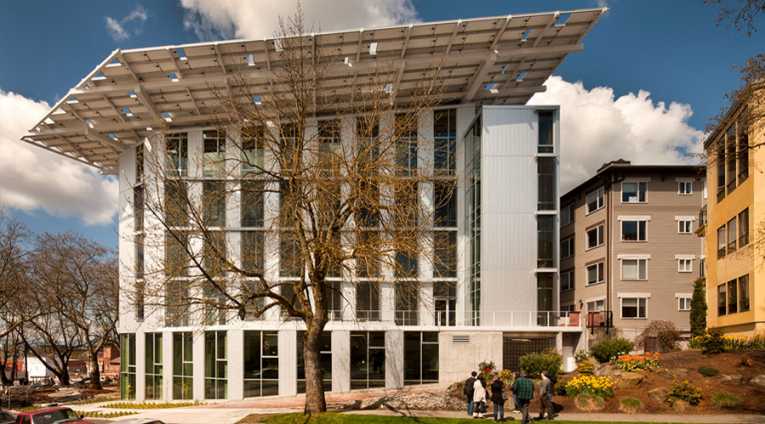Two years ago, at a cost of $18.5 million a significant 6-story office building reared into the Seattle sky. Final overall costs hover around the $32.5 million level, with 90% occupancy. It is now classed as a living building
because of the incredible efforts made to convert normality into chemical-free (well, free of 300 toxic chemicals, as chemistry can also be green
), extreme- environment-friendly timber and concrete construction. A steel lateral system is needed as the area is seismically active. The heat from the geothermal wells is likely to be connected to that fact. Now more extremely energy efficient buildings, such as Stone34, seem certain to be built in Washington State, USA, and hopefully in many other locations.
The Bullitt Building had DCI Engineers as structural consultants and was designed by the Miller Hull Partnership. Climate control is passive, while all of the water supply is obtained from Seattle’s frequent rainfall on the actual structure. Photovoltaic (PV) cells on the roof hope for enough solar power to supply all electrical needs. The residents are environmental-freindly companies, accompanying the actual Bullitt Foundation. The Miller Hull site gives us a plethora of inside shots of wood frames and the tiny footprint of what is quite a large building, sitting on a corner site.
Figures on the efficiency of buildings are of course now de rigeur. This energy miser has generated 60% more energy than that used by its residents (who also achieved their own zero electricity costs) with the so-called energy use intensity measured at 9.4 (the average is around 60, so we can assume this is a low figure.) Printers, computers (now all laptop) and similar appliances use half of the electricity. Energy saving measures are applied in every office. The real-life accomplishments focus on sewage, geothermal wells digging 400 feet deep for heat and maintaining good relations with an authority that is actually very eco-minded itself.
52,000 gallons of rain gather in a great cistern for water supply while drainage from sinks and showers travels through a wetland area before draining away. Composting toilets use little of the water with the composting system disposing of waste as potting compost after 18 months. Sewer fees are apparently paid occasionally, meaning some visitors must be queasy. Rents is typical for downtown Seattle at $40.18 per square foot, inclusive of operating costs and maintenance. No car parking is available, but your bike can find its own space. If you want to ride the elevator/lift, don’t! They prefer you to watch the sky-high views from the stirs- it is only 6 stories, after all.
After 250 years, the idea is to pull it down and do it again. 21 other buildings in the world are in this living building club. All process their sewage, generate at least as much energy as that used and supply their own water. Difficult for the smaller examples, as it would probably be easier to buy a great section of rainforest and simply use the facilities. Bullitt is the biggest or at least the tallest and probably the most commercially successful, given its Seattle environment. Denis Hayes, the Bullitt CEO, claims this building resembles a Douglas fir forest. Functionally, it is, but that wetland area could be great for more wildlife attention and the roof could also benefit from those upcoming PV cells that will be much more efficient.
Further buildings were shown in an article on some of our sustainable housing here, while perceptions of how green each nation thinks it is are intriguing.










